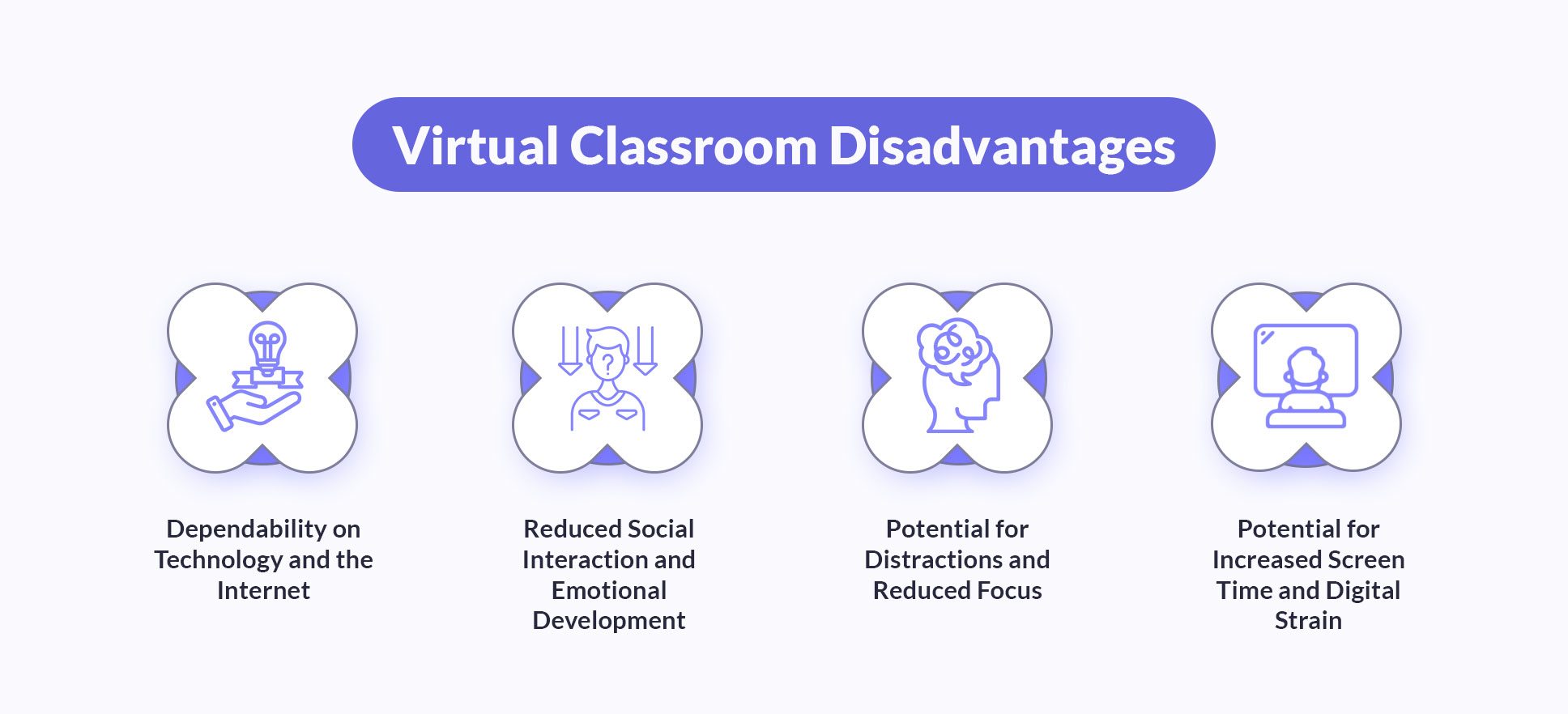There has been an increasing demand for online courses due to their benefits to institutions and students.
- 63% of online students who took a virtual classroom say it's convenient, saves time, and aligns well with their work-life balance.
- Institutions, on the other hand, save on infrastructure costs, scale their businesses easily, and offer courses to students beyond the national territories with the help of online programs.
If you’re an Edtech company looking to scale and cater to market demand, you might benefit from applying virtual learning software. In this article, you’ll discover the advantages and disadvantages of virtual classrooms and some major trends to consider.
In this article:
Growing popularity and importance of virtual classroom software in online teaching
When COVID-19 hit the world, the growth of virtual learning and online classes skyrocketed. What was previously a luxury or a “skeptical thing” has become necessary. Teachers started online lectures and gave presentations, and students adapted to the situation because they had to!
Today, this trend has emerged even further because of the numerous advantages of virtual classroom methodology over traditional lecturing. Global industry analysts’ report shows that the global e-learning market will reach $686.9 billion by 2030. Naturally, with the growing demands of online learning, the demand for virtual learning software will increase!
Pros of virtual classroom software

1. Increased accessibility and flexibility
Virtual education creates an environment for both synchronous learning and self-paced learning (students can study on their own schedule), and this is one of the most important advantages of virtual learning. They get the learning material digitally and can manage their study time per their preferences. It breaks the geographical barrier and allows more students to learn—students who can’t take regular physical classes due to their busy schedule, distance, or disabilities.
Additionally, organizations can ask teachers to use video conferencing and other teaching tools, providing flexibility.
2. Cost-effectiveness and scalability
Virtual learning software enables virtual learning environments for learning on the internet, accommodating more students than a typical classroom. This online learning method is scalable and cost-effective.
An online learning environment can save you 70% or more than traditional classrooms.
This is because you eliminate physical classrooms and cut costs, such as employee and teachers' salaries, rent for the classroom space, equipment and utility bills.
You can expand your business to global markets and develop robust virtual learning platforms with these extra savings.

You may be interested
How to create a good school management software: 8 key features you should consider
Learn about the essential features that make school administration smoother and communication more efficient.
Continue reading3. Improved data integration and analytics
It is not easy to track specific metrics of students and teachers performance in a regular classroom. You never know how a specific class went, how well a teacher did their job, and how well students understood the material and executed their part.
Once you switch to developing virtual learning software for digital learning, this vagueness goes away. Now, you can track metrics such as attendance, course completion rate, and learning effectiveness, and you can gather students' feedback in online lessons.
The data points are captured and available in analytics to help teachers and institutions make informed decisions. Also, you can accurately predict students’ performance by tracking specific behavioral metrics. This allows teachers and administration to understand which students need special attention.
4. Global reach for students
Another important point for virtual classroom benefits is that it expands the worldview of students. A class full of students from all over the world and a collaborative mindset may create endless possibilities for ideas, innovation, and growth.
Institutions learn the demands of students from different corners of the world. Students meet other students (and sometimes create amazing things together) and learn from each other in online courses. Teachers can adopt different mindsets, too!
Overall, there’s a growth opportunity for everyone. You invite students from around the globe and prepare them to thrive in this global workforce economy with the help of virtual learning software.


Thank you for Subscription!
5. Better collaboration among teachers and other professionals
Virtual classroom software enables face to face communication between teachers and learners. It allows features like live text chat, interactive whiteboard, application sharing, and breakout rooms for more fun learning sessions. When teachers and students collaborate, it eliminates the tension between them and boosts creativity on many levels.
For example, with live chat and video conferencing, teachers can easily share ideas and ask students to participate in online discussions. Similarly, teachers can create shared virtual spaces like digital whiteboards, where multiple teachers can contribute simultaneously. It helps in brainstorming ideas and creating visual maps/diagrams together.
With the effective use of these features, you can enable seamless and productive collaboration in online virtual classrooms at scale across geographies. It saves you significant time and effort over a traditional classroom setting with coordination between teachers and professionals.
6. Enhanced engagement from learners
Engagement has been a problem with regular classrooms. While it can’t decrease entirely with virtual classrooms, there are several features you can demand in your virtual classroom software to dramatically increase the engagement of learners.
Some ways virtual learning software enhances the learning experience and enables enhanced learner engagement in online education are:
Interactive features like polls, quizzes, and virtual hand-raising increase student engagement.
Online whiteboards where both instructors and students can contribute (the ability to draw visual graphs further engages learners).
Breakout rooms (to collaborate with other students via chat, audio, and video on projects while learning online).
Gamification features like badges and leaderboards motivate your students to complete tasks and attend virtual classes regularly by rewarding participation.
This is a really great advantage of a virtual classroom:)
7. Promotes personalized learning expirience
Consider this example: Khan Academy is a non-profit Edtech platform that uses personalized learning methodologies. It reaped the advantages of virtual learning and increased the efficacy of learners. In essence, students who used Khan Academy were able to improve their scores in mathematics over time.
Virtual classrooms provide the perfect environment for personalized learning. With data analytics, organizations can get accurate information on where a student is lacking.
Virtual classroom software features like poll questions with private teacher comments or annotation tools can encourage one-on-one guidance interactions between teachers and learners during live classes. Additionally, it allows students to figure out the best time for their learning.
If you’re an Edtech company looking to break through in the industry, you must have your virtual learning environments ready. If you haven’t yet created one for your organization, you can get help developing virtual classroom software.
8. Immediate test & exam feedback
Learning online allows you to provide test & exam feedback immediately. Since each lesson is conducted through online channels, there is no need to wait for the next day of training to provide feedback or learning outcomes. Teachers communicate with students through various forms of digital platforms, online channels, and chats.
If you are a teacher and choose individual learning platforms, you can even use various automation tools that facilitate the process and provide feedback absolutely instantly. Believe me, the power of test automation in education is greater than you imagine.
For example, some virtual classrooms allow you to create a quiz or test, and students receive the results as soon as they take the test and submit their answers. The system automatically checks the results, of course, taking into account the correct options that you provide in advance. Isn't that great? Of course, it is:)
9. Automation Assistance
As you have already understood, automation is one of the greatest benefits of virtual classroom. It helps you save your time, energy and effort that was previously spent on mechanical work. Now you can avoid this and automate the learning process, regardless of your industry or field of classroom activity. Everything is teachable, and teaching in any industry can be automated.
In addition to tests, you can also automate the process of creating certificates. The system can automatically create certificates for those students (with names registered on your platform) who have passed the tests with positive grades.
Cons of virtual classroom software development

1. Dependability on technology and the Internet
One of the not-so-good things about online education is that it creates dependency on the internet and technology. While most of the world is fully connected to the internet, there are still some parts where getting a reliable and fast internet connection isn’t cheap or easy. In such remote locations, students can’t fully utilize the benefits of virtual learning.
But as a company, you can tackle that. You can make your virtual classroom software work even at slow internet speeds. Your software can have adaptive streaming, restricted data usage, or a feature to download classes.
2. Reduced social interaction and emotional development
Confined space and reduced engagement are other disadvantages of online learning students may face. They typically sit in a secluded environment to take the online course, where less human interaction is involved, sometimes creating difficulties for students who struggle to form bonds.
Ensure your online education software has the necessary features to solve this problem. Breakout rooms can help you divide the classroom into smaller groups and boost engagement. Additionally, you can provide virtual spaces for informal learning activities between students and tutors.
When students feel included, they’re more likely to interact and become emotionally intelligent as they learn.
3. Potential for distractions and reduced focus
Students can use television, mobile phones, or communicate with their family members when taking virtual classes from home. Such distractions make it harder for students to focus on learning.
Moreover, factors like lack of supervision in a structured classroom, no peer effect from fellow students focusing intently on online studies, and no change of study scenery from the home setting make prolonged home-based online learning mentally challenging.
However, education platforms and virtual classrooms can implement engagement analytics, browser-locking features, classroom norms, and etiquette reminders to help students minimize distractions. Ensure you have stringent features in your online classrooms to keep learners’ attention.

Learn more
AI in Edtech: top AI-based Edtech solutions
See how AI is making education more personalized, assessments smarter, and learning more fun.
Explore4. Potential for increased screen time and digital strain
This is one of several disadvantages of virtual classroom software. In Internet education, you learn primarily via computers, laptops, tablets, and smartphones. It causes increased screen time for you, unlike a traditional classroom.
Prolonged use of digital devices and continuous internet access causes digital eye strain, triggering headaches, blurred vision, and physical problems like back/neck pain. Additionally, limited physical movement hampers overall wellness.
Some solutions include enabling device breaks during long classes to rest eyes and promoting off-screen collaborative exercises. Students must develop time management skills and restrict their digital time.
Edtech companies and educational institutions can also educate parents and students about healthy device usage habits and movement exercises. Your virtual classroom software can have features to send reminders about such issues.
Emerging e-learning trends
With the growing popularity of e-learning in higher education and corporate education, transformation is inevitable.
AI is entering every industry, and this is the most powerful trend.
Companies can use AI to personalize education and make better sense of the data they gather and better supervise students acquiring digital skills. For instance, a machine learning algorithm can analyze a student’s performance and inform the educators.
Further, virtual learning will be a big thing in the future. The VR immerses you and places you in a virtual classroom. You could interact with other students and talk in real time, just like in real life.
Another exciting trend is video-based learning. Video engages more than plain text, so video courses sell better. For example, take a finance education platform developed by Geniusee, Finance Unlocked. It harnesses the power of video to engage learners.
Ready to innovate?
Explore our Edtech services — we create solutions that fit your needs perfectly.
Conclusion
Now you know the major virtual classroom advantages and disadvantages.
From the benefits of online education like accessibility of learning materials, data integration, and cost-effectiveness, virtual learning opens geographical boundaries and brings new possibilities to modern education.
Sure, there are certain drawbacks in distance learning, but with a feature-rich learning management system, you can tackle those for your online classes. Getting your virtual classroom software developed by a trusted company is necessary for a robust, feature-rich, real classroom-like environment.





















